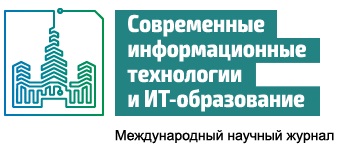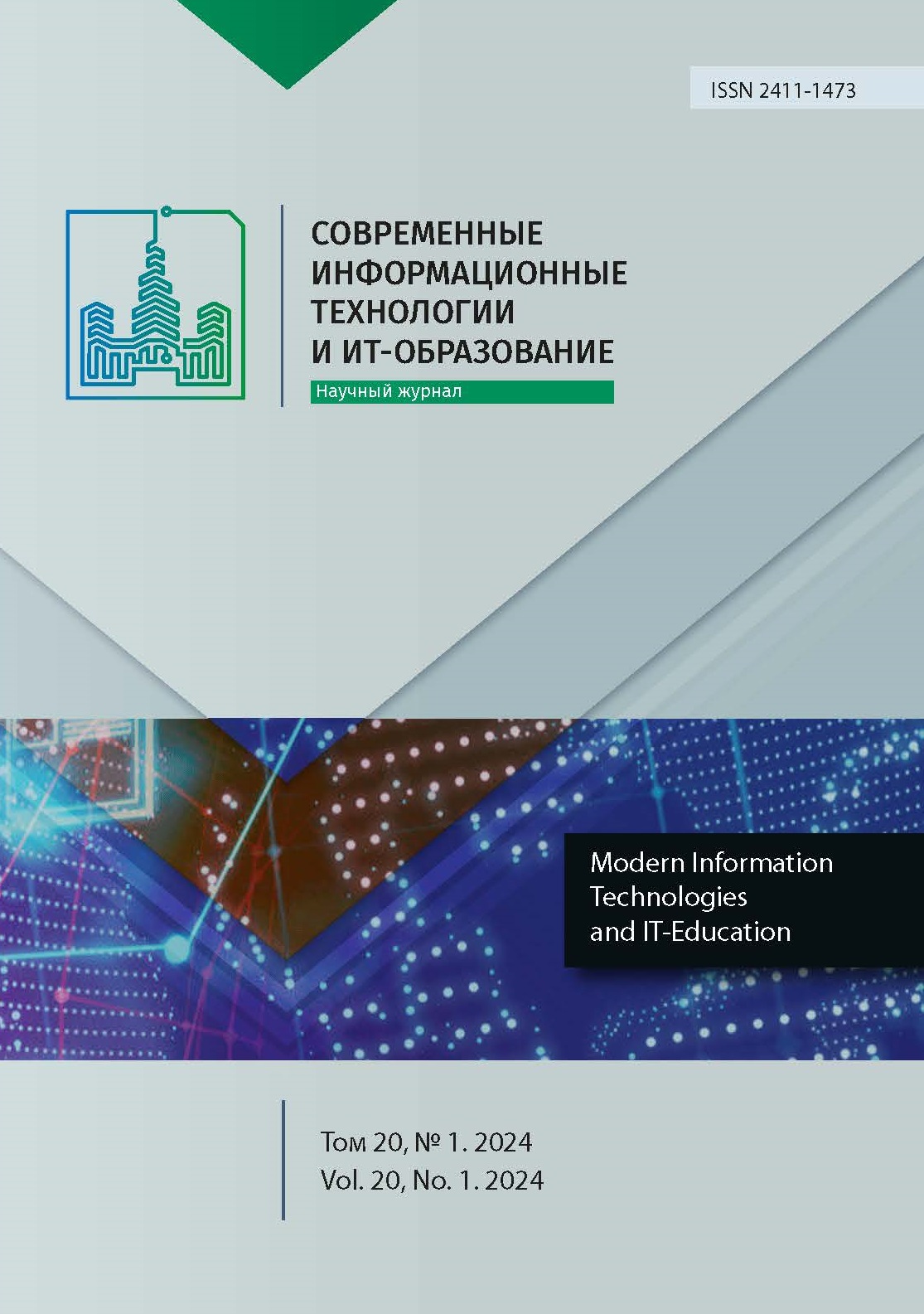Intellectualization System for Information Resources Usability Testing
Abstract
The article discusses the possibilities of predicting the state of the web resources usability. Next, modeling and predicting system the time series of the site page visitors number is proposed. The usability testing procedure is quite costly from both financial and time points of view. Thus, a system that reduces these costs is useful for modern organizations. Different approaches of forecasting the number of visitors: ARIMA model and Neural Networks are considered. An important time series property for ARIMA model being applicable is the stationarity of the series. It is shown that this model is not suitable enough for the investigated time series, some types of neural networks are also not suitable for various reasons. As a result, NARX networks are selected, which are successfully used for time series forecasting, providing an opportunity to use an exogenous variable. Proposed model using the NARX neural network. The developed application allows evaluating the usability of information resources according to the following parameters: page functionality, accessibility (convenience of location) of the main buttons on the page, colors, type and size of headings and body text. The application helps to predict the traffic of a web resource based on a time series of site visits without usability testing by experts, by comparing simulation results with the results of a full-fledged usability test.
References
2. Khajouei R., Zahiri Esfahani M., Jahani Y. Comparison of heuristic and cognitive walkthrough usability evaluation methods for evaluating health information systems. Journal of the American Medical Informatics Association. 2017;24(e1):e55-e60. https://doi.org/10.1093/jamia/ocw100
3. Roscoe R.D., Craig S.D. A Heuristic Assessment Framework for the Design of Self-Regulated Learning Technologies. Journal of Formative Design in Learning. 2022;6:77-94. https://doi.org/10.1007/s41686-022-00070-4
4. Astachova I.F., Makoviy K.A., Khitskova Y.V. Possibilities for predicting the state of usability web resources. Journal of Physics: Conference Series. 2021;1902(1):012029. https://doi.org/10.1088/1742-6596/1902/1/012029
5. Hussain A., Mkpojiogu E.O., Kamal F.M. A systematic review on usability evaluation methods for m-commerce apps. Journal of Telecommunication, Electronic and Computer Engineering. 2016;8(10):29-34. Available at: https://jtec.utem.edu.my/jtec/article/view/1361 (accessed 09.12.2023).
6. Fleifel R.T., Soliman S.S., Hamouda W., Badawi A. LTE Primary User Modeling Using a Hybrid ARIMA/NARX Neural Network Model in CR. In: 2017 IEEE Wireless Communications and Networking Conference (WCNC). San Francisco, CA: IEEE Computer Society; 2017. p. 1-6. https://doi.org/10.1109/WCNC.2017.7925756
7. Kavasseri R., Seetharaman K. Day-ahead wind speed forecasting using f-ARIMA models. Renewable Energy. 2009;34(5):1388-1393. https://doi.org/10.1016/j.renene.2008.09.006
8. Cadenas E., Rivera W., Campos-Amezcua R., Heard C. Wind Speed Prediction Using a Univariate ARIMA Model and a Multivariate NARX Model. Energies. 2016;9(2):109. https://doi.org/10.3390/en9020109
9. Domingos P. A Few Useful Things to Know About Machine Learning. Communications of the ACM. 2012;55(10):78-87. https://doi.org/10.1145/2347736.2347755
10. Tun C.C., Majid N.O.R.I.Z.A. Comparison between artificial neural network and autoregressive integrated moving average model in bitcoin price forecasting. Journal of Quality Measurement and Analysis. 2018;14(2):45-53. Available at: https://www.ukm.my/jqma/v14_2/jqma-14-2-paper5.pdf (accessed 09.12.2023).
11. Mitrea C.A., Lee C.K.M., Wu Z. A Comparison between Neural Networks and Traditional Forecasting Methods: A Case Study. International journal of engineering business management. 2009;1(2):67-72.
12. Zhang H., Wang Z., Liu D. A Comprehensive Review of Stability Analysis of Continuous-Time Recurrent Neural Networks. IEEE Transactions on Neural Networks and Learning Systems. 2014;25(7):1229-1262. https://doi.org/10.1109/TNNLS.2014.2317880
13. Dorogov A.Yu. Deep Learning Neural Networks with Controlled Switching of Neural Planes. CEUR Workshop Proceedings. 2019. Vol. 2834. p. 111-124. Available at: https://ceur-ws.org/Vol-2834/Paper10.pdf (accessed 09.12.2023).
14. Zhang Y.-D., Pan C., Chen X., Wang F. Abnormal breast identification by nine-layer convolutional neural network with parametric rectified linear unit and rank-based stochastic pooling. Journal of Computational Science. 2018;27:57-68. https://doi.org/10.1016/j.jocs.2018.05.005
15. Dong G., Liao G., Liu H., Kuang G. A Review of the Autoencoder and Its Variants: A Comparative Perspective from Target Recognition in Synthetic-Aperture Radar Images. IEEE Geoscience and Remote Sensing Magazine. 2018;6(3):44-68. https://doi.org/10.1109/MGRS.2018.2853555
16. Heuillet A., Nasser A., Arioui H., Tabia H. Efficient Automation of Neural Network Design: A Survey on Differentiable Neural Architecture Search. ACM Computing Surveys. 2024;56(11):270. https://doi.org/10.1145/3665138
17. Serikov T., Zhetpisbayeva A., Mirzakulova S., Zhetpisbayev K., Ibrayeva Z., Tolegenova A., Soboleva L., Zhumazhanov B. Application of the NARX Neural Network for Predicting a One-Dimensional Time Series. Eastern-European Journal of Enterprise Technologies. 2021;5(4(113)):12-19. https://doi.org/10.15587/1729-4061.2021.242442
18. Ashok Kumar D., Murugan S. Performance analysis of NARX neural network backpropagation algorithm by various training functions for time series data. International Journal of Data Science. 2018;3(4):308-325. https://doi.org/10.1504/IJDS.2018.096265
19. Haviluddin, Dengen N. Comparison of SARIMA, NARX and BPNN models in forecasting time series data of network traffic. In: 2016 2nd International Conference on Science in Information Technology (ICSITech). Balikpapan, Indonesia: IEEE Computer Society; 2016. p. 264-269. https://doi.org/10.1109/ICSITech.2016.7852645
20. Yu X., Chen Z., Qi L. Comparative study of SARIMA and NARX models in predicting the incidence of schistosomiasis in China. Mathematical Biosciences and Engineering. 2019;16(4):2266-2276. https://doi.org/10.3934/mbe.2019112
21. Chen A., Law J., Aibin M. A Survey on Traffic Prediction Techniques Using Artificial Intelligence for Communication Networks. Telecom. 2021;2(4):518-535. https://doi.org/10.3390/telecom2040029
22. Bilski J., Galushkin A.I. A New Proposition of the Activation Function for Significant Improvement of Neural Networks Performance. In: Rutkowski L., Korytkowski M., Scherer R., Tadeusiewicz R., Zadeh L., Zurada J. (eds.) Artificial Intelligence and Soft Computing. ICAISC 2016. Lecture Notes in Computer Science. Vol. 9692. Cham: Springer; 2016. p. 35-45. https://doi.org/10.1007/978-3-319-39378-0_4
23. Konstantinidis S., Karampiperis P., Sicilia M.-A. Enhancing the Levenberg-Marquardt Method in Neural Network training using the direct computation of the Error Cost Function Hessian. In: Proceedings of the 16th International Conference on Engineering Applications of Neural Networks (INNS) (EANN '15). New York, NY, USA: Association for Computing Machinery; 2015. Article number: 2. https://doi.org/10.1145/2797143.2797162
24. Zhang S., Huang H., Han Z. A Levenberg-Marquardt Algorithm Based Incremental Scheme for Complex-Valued Neural Networks. In: 2019 IEEE Symposium Series on Computational Intelligence (SSCI). Xiamen, China: IEEE Computer Society; 2019. p. 1479-1485. https://doi.org/10.1109/SSCI44817.2019.9003091
25. Boussaada Z., Curea O., Remaci A., Camblong H., Mrabet Bellaaj N. A Nonlinear Autoregressive Exogenous (NARX) Neural Network Model for the Prediction of the Daily Direct Solar Radiation. Energies. 2018;11(3):620. https://doi.org/10.3390/en11030620

This work is licensed under a Creative Commons Attribution 4.0 International License.
Publication policy of the journal is based on traditional ethical principles of the Russian scientific periodicals and is built in terms of ethical norms of editors and publishers work stated in Code of Conduct and Best Practice Guidelines for Journal Editors and Code of Conduct for Journal Publishers, developed by the Committee on Publication Ethics (COPE). In the course of publishing editorial board of the journal is led by international rules for copyright protection, statutory regulations of the Russian Federation as well as international standards of publishing.
Authors publishing articles in this journal agree to the following: They retain copyright and grant the journal right of first publication of the work, which is automatically licensed under the Creative Commons Attribution License (CC BY license). Users can use, reuse and build upon the material published in this journal provided that such uses are fully attributed.













